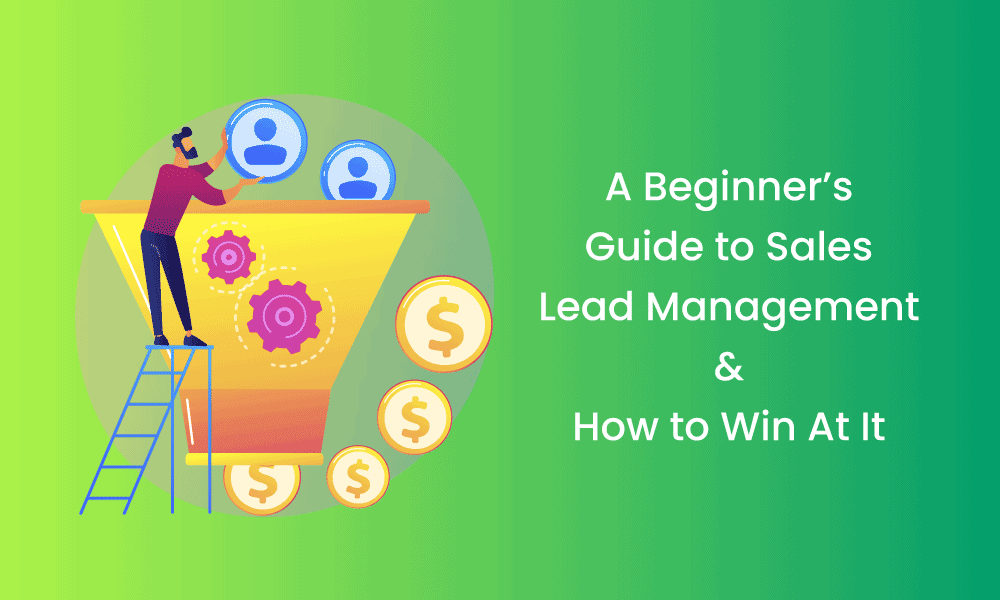If sales are your main focus, it’s important to optimize sales lead management.
Sales lead management is the process of turning sales leads into sales opportunities. As a business owner, you want to build up momentum in the pipeline to ensure that revenue grows.
Unfortunately, generating sales leads can be one of the most frustrating parts for marketing and sales teams because many leads fall through the cracks or aren’t even qualified for sales contact.
If you want your sales engine running smoothly, you have to optimize major processes including lead management.
In this blog post, you’ll learn about:
- Sales leads
- Sales lead management
- The stages in a sales lead management system
- How to generate sales leads like a boss
- How a CRM software can transform your sales lead management.
Read on!
Table of Contents
What Is Sales Lead Management?
Sales lead management is a system that sales teams rely on to keep their sales engine running smoothly.
It helps salespeople build up momentum in their pipeline to ensure that revenue growth is steady. Managing sales leads entails organizing and identifying the stage your leads are currently present in. The sales team or sales rep follows up accordingly with these sales leads until a sale is closed or it becomes obsolete.
When you think about sales lead generation, defining what a sales lead actually is can become overwhelming fast because there really isn’t one universal definition that fits every company.
For example, if your business sells software used by small businesses to manage finances for them, then anyone who downloads your free trial would be considered a potential customer or sales lead! This means that anytime someone comes across any piece of information from your brand, whether physically or digitally (i.e., website visitors, social media followers) — this person could be a sales lead.
As a salesperson, you can’t just have everyone who comes across your brand’s information to be considered potential sales leads because then it would cost thousands of dollars for you to even reach out to all these people individually.
This is one downside of having too broad a definition for sales leads, which means that there are countless sales opportunities waiting on the other end but they’re not in any way organized or prioritized.
The good news is that when companies want to grow and scale their business, more often than not, they can rely on certain tools like sales lead management software to manage their lead data effectively. This way, they don’t lose track of anyone [and] thus generate more revenue!
Read also: A Guide to Sales Prospecting — A Few Modern Techniques
What Are Sales Leads?
A sales lead is a potential customer. Sales leads are people who have shown interest in what you have to offer, but they might not be ready yet to purchase from you right away.
As sales managers, your job is to evaluate sales opportunities and keep track of all sales leads so that we know which ones are the highest priority to follow up with.
There are many different ways to manage sales leads, with systems that can help you classify them based on their stage.
Sales managers spend time evaluating sales opportunities and trying to close them as quickly as possible. They need a way to organize the sales process into manageable chunks, and it’s important for them to be able to prioritize those chunks as well.
Related blog: How to Build a Perfect Sales Strategy
The 5 Stages of a Sales Lead Management System
We talked in an earlier section about why managing sales leads using a system is so crucial for your business. But, how exactly do you create a sales lead management system?
We’ll discuss the stages involved in detail now.

Lead Capture
Before you can judge whether a lead is qualified or not, you have to first capture it. Lead capture is just another way of referring to lead generation.
There are many different ways you can capture a lead: marketing campaigns, social media advertising, lead magnets, etc. You can offer downloadable checklists and guides in exchange for a lead’s contact information. Such an incentive is known as a lead magnet.
During the lead capture stage, you don’t necessarily know if your leads are qualified or not. Regardless, you want to generate a healthy and consistent number of leads for your company over time.
The reason for this is that not every qualified lead will convert. Your conversion rate also varies by industry. The lead capture rate in the health & wellness vertical differs from that of a SaaS company.
To combat your sometimes-low conversion rates, having many leads as part of your lead gen process is crucial — and increases lead qualification rate.
Read also: How to Build Incisive Lead Capture Pages
Lead Tracking
Once you’re done gathering the contact information for your first group of leads, they move on to the second phase of the management system: lead tracking.
Through lead gen, you could gather cursory information on the lead, such as their first and last name, phone number, email address, home address, and even perhaps their occupation, as part of managing sales leads.
This information is handy, but it’s not all you need. You also want to gather behavioral data on your leads. This is where lead tracking comes in.
By tracking your leads, your sales and marketing teams can begin planning their approach. You want to qualify your lead based on behavioral data, lead source information, and other metrics, which can help you figure how willing a customer may be to pay.
You can track leads by sending them surveys, through email marketing, or even by analyzing website visits. Having this information can clue you in on the lead’s needs, or at least what they’re interested in.
What happens from here, including the sales pitch, outreach, and messaging, will all keep in mind the information determined during the lead tracking phase.
Read also: The Functions of Sales Management: What Every Team Lead Needs To Know
Lead Scoring

When you score a lead, you assign them a value that determines how likely they are to convert. Having a common lead scoring system that the entire sales team can use is of the utmost importance to ensure all leads are scored on the same criteria.
You can create your own lead-scoring system based on contact information, opportunity size, lead behavior, etc. Regardless of your design strategy, lead scoring helps salespeople prioritize which leads to follow up on.
For example, let’s say your lead signed up for your newsletter, giving you their contact information. They may earn themselves one point. Next, the lead receives your email and takes the time to respond. This may net the lead two points. If the lead went out of their way to speak with you on the phone for 20 minutes, you might give them something like five points.
Like we said, it goes both ways. If a lead unsubscribes to your newsletter, you might subtract three points. If they schedule a meeting with you and then don’t show up, you could deduct 10 points.
You then tally up all the lead scores and see which quality leads have the highest scores. This is the group you want to target first while managing sales leads.
Lead Distribution

With your leads scored, you now move on to the fourth phase, which is the lead distribution system, also called lead routing.
You can assign leads to your salespeople as you see fit: random, based on geography, company size, etc. The sales team and sales reps will begin contacting the lead through phone or email, which is called lead nurturing. We’ll discuss this in detail later.
You can execute a drip campaign if you’re still unsure about your leads. Most qualified leads, especially sales-qualified and marketing-qualified leads (SQLs and MQLs, respectively) should react positively to a well-executed drip campaign. This is an important part of the sales funnel.
The information and education the lead will receive via this marketing campaign can push them toward either buying from your company or ending the customer journey early.
Read also: Top 8 Product Manager Certifications: Let’s Do This
Lead Nurturing
Lead nurturing is the stage where you focus mostly on discussing the lead’s pain points, not pushing a product or service. Just because they displayed an interest in your product or service doesn’t mean they’re ready to buy.
You want to build a relationship with the lead — understand their issues and expectations. You can then present a solution (through your products and services) that seems tailored to the lead.
Nurturing and engaging with leads does not only have to be done on the phone. In-person meetings, as is email, are one such way to push the professional relationship along.
Generating and Managing Sales Leads Like a Boss: 8 Awesome Tips
Now that you have a better understanding of managing sales leads, let’s rewind it all the way back to the beginning of it.
You need sales leads to begin lead gen. How do you even find these leads? You can rely on many methods, so we’ll discuss some important ones here.
Host Networking Events
You don’t only have to pull in leads from the Internet. Sometimes, your next great customer stands right before you at that expo or convention.
If you can, try to target events that are related to your industry or niche. The people who attend these events do so because they are interested in your field.
If you’re attending a networking event as a guest, make sure you print out many business cards to pass around. You don’t immediately have to start selling. For now, it’s all about striking up a conversation.
Host Webinars
Another option you have to attract leads is to host a webinar.
By targeting your leads’ related industries or interests, you can gain their attention. The leads who want to check out your webinar will have to sign up to do so, giving you their contact information.
You can also host joint webinars with other related businesses and drum up interest that way. Joint webinars offer you a wider audience base.
You can send a lot of emails pertaining to the webinar that can also act as lead nurturing. Outside of the reminders that the webinar is coming up in X days, you might email your attendees and ask what they’d like to hear about in the webinar.
Send feedback requests after every webinar because it can go to waste if you don’t understand the impact of your sales and marketing effort.
Use SEO for Lead Generation
If your company’s website isn’t already at the top of the heap when a user searches for certain keywords, then that’s something you’re going to want to strive to change immediately.
Search engine optimization, or SEO, determines which websites get to the top, which matters a lot for lead gen.
The best practices surrounding SEO continue to change as Google algorithms update. If you can learn about which factors most determine your rank as a company, that’s best, as you can make the necessary changes to boost your site.
Implementing the following SEO tactics is also always a good idea if you’re not already doing so while managing sales leads:
- Have an active social media presence, posting valuable content regularly
- Prioritize the loading speed of your website
- Optimize your site for SEO, but don’t forget that the user experience matters most
- Write educational yet entertaining blogs and post them regularly
- Make sure your site is mobile-optimized
Advertise Online
Another way to connect with leads who can become potential customers is to use online advertising.
Pay-per-click campaigns through Google AdWords is an especially recommended avenue to consider. You design your ad and determine where it goes. Then, through PPC, you can track clicks.
Online advertising doesn’t just work completely on its own.
You’re redirecting customers to your website, so your site has to be ready to capture the information of these leads so you can move on to the second phase of managing sales leads.
Don’t forget that outside of website advertising, social media platforms like LinkedIn, Twitter, Instagram, and Facebook have their own paid advertising programs.
Add Live Chat to Your Website
Does your website have a live chatbot? If not, then you can add one via a chatbot builder sooner rather than later.
This chat widget will greet your leads as soon as they arrive at your website. If the lead has a question about your company, what you do, and what you sell, they can ask the chatbot and get an informative answer.
Besides just answering questions, the chatbot could communicate, share relevant phone numbers, and even schedule meetings.
By keeping a log of all the chat records the chatbot has daily, you can see which topics and pain points your leads query about the most.
Read also: What is a Chatbot and How to Use It For Sales & Marketing
Try Social Listening
If you know the key search words that your leads associate with your company, you can use social listening tools to generate leads. Lead management software offers various social listening tools that you can use.
The most common social listening platforms include HubSpot, Sprout Social, Hootsuite, and many alternatives.
You can monitor the conversations around your brand, interact with your customers, resolve queries, and drive engagement. It’s also a great way of building a brand image.
Make the Most of Email Marketing
One lead gen option your company certainly wants to use is email marketing, with email sequences especially coming in handy at this early phase of the lead management system.
Lead management software helps you create email sequences to reach customers at the right time.
First, you want to send an email that shows your company connects to the lead’s pain points. Next, you slowly introduce your products and services without being pushy or salesy.
Four or five emails in, you finally recommend some products and services to help the lead overcome their pain point so their life is better, happier, or less complicated.
You’d follow up if necessary and the sequence would end.
By this point, the lead will have hopefully bought your product or service. If so, you can start a whole new email sequence now that they’re a verified customer.
Start a Referral System
Word-of-mouth marketing still remains the most persuasive form of advertising. This process doesn’t involve the leads directly, but rather, your customers.
Reach out to some of your most long-term, loyal customers and request that they turn to their social circle and suggest prospective customers to you.
As a way of showing appreciation for their assistance, you could consider offering the customer something in return, such as an exclusive discount code or even a freebie, as part of your efforts in managing sales leads.
Why a CRM Software Is Considered the Best Lead Management System
Effective lead management is not a one-person show. It involves many different people with their own processes and workflows. If you don’t effectively streamline the sales process, it can turn messy and complicated.
A CRM (Customer Relationship Management) software empowers you with the tools you need to create great profiles for all your contacts. You can edit, update, and track all pertinent information from one common dashboard, for thousands of contacts.
You can even use the CRM software to score your leads. Since you’re trying to create a consistent lead scoring system as part of your sales lead management system, using a CRM solution for this purpose is a no-brainer.
If you have multiple sales pipelines, you can use a CRM software to organize and automate all those workflows.
EngageBay’s CRM is a great choice: thousands of business owners around the world love the affordability and simplicity it offers. You get such key lead management features as:
- Call integrations
- Lead scoring
- Email syncing
- Sales team leaderboards
- Sales reporting and analytics
- Customer interaction records
- Automated data entry logging, follow-ups, meeting scheduling, and more
- Advanced view of the deal pipeline
- Contact management
The best part? You get all of this even in the free plan!
Conclusion
Are you looking for a better way to manage your sales leads? Is managing sales leads a hectic process for you?
If you’re not using a CRM software, you’re probably wasting time and money on ineffective lead management. You can be sure that if you don’t have the right tools in place, your sales team is going to struggle with managing their sales pipeline.
In this blog post, we covered all aspects of sales lead management and the importance of implementing a system that works for your business.
A good sales lead management system should help improve communication between all members of the team, so everyone knows where they stand when it comes to meeting goals and quotas.
It should also provide accurate information about each prospect from initial contact through closing deals, so nothing falls through the cracks or gets lost along the way.
Want great sales lead management tools? See how EngageBay can help your business.
